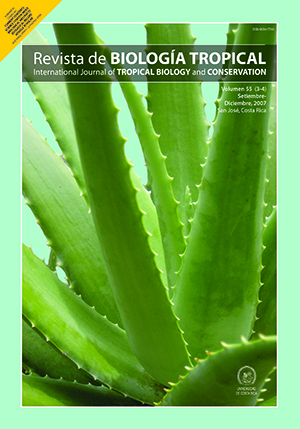Abstract
The karyotypes of the purple snails Plicopurpura pansa (Gould, 1853) and P. columellaris (Lamarck, 1816) were established from 17 and 13 adults, respectively; and from eight capsules with embryos of P. pansa. In P. pansa were counted 59 mitotic fields in the adults and 127 in embryos; and 118 fields in P. columellaris. Chromosome numbers from 30 to 42 were observed in both species. Such a variation was notorious in each sample and there was no evidence of any relationship with tissue (gill, muscle and stomach). Both species has a typical modal number of 2n=36 chromosomes. Five good quality chromosome spreads were selected from adults of each species to assemble the karyotype. Classic cytogenetics statistics like relative lengths, arm ratio, centromeric index and the difference between long and short arms are presented. There were three pairs of metacentric and fifteen pairs of telocentric chromosomes in both species. This classification was not strong enough, so the chromosome complement by species was divided in four groups (“a”, “b”, “c” and “d”) on the basis of relative lengths (p+q). A comparison of p+q in each chromosome pair was estimated within and between species by two ways analysis of variance and Tukey tests (P<0.05). Significant differences were identified among chromosome groups in each species; the differences between species were given by the first three pairs of chromosomes (group “a” biarmed) and the last two pairs (group “d” uniarmed). Deviations in chromosome number and relative lengths probably are given by chromosome rearrangements, related with chromosome polymorphism and presence of the atypical microchromosome “B”. The fundamental number in both species was characterized by 42 chromosome arms. No sex chromosomes were identified.
Comments

This work is licensed under a Creative Commons Attribution 4.0 International License.
Copyright (c) 2007 Revista de Biología Tropical






